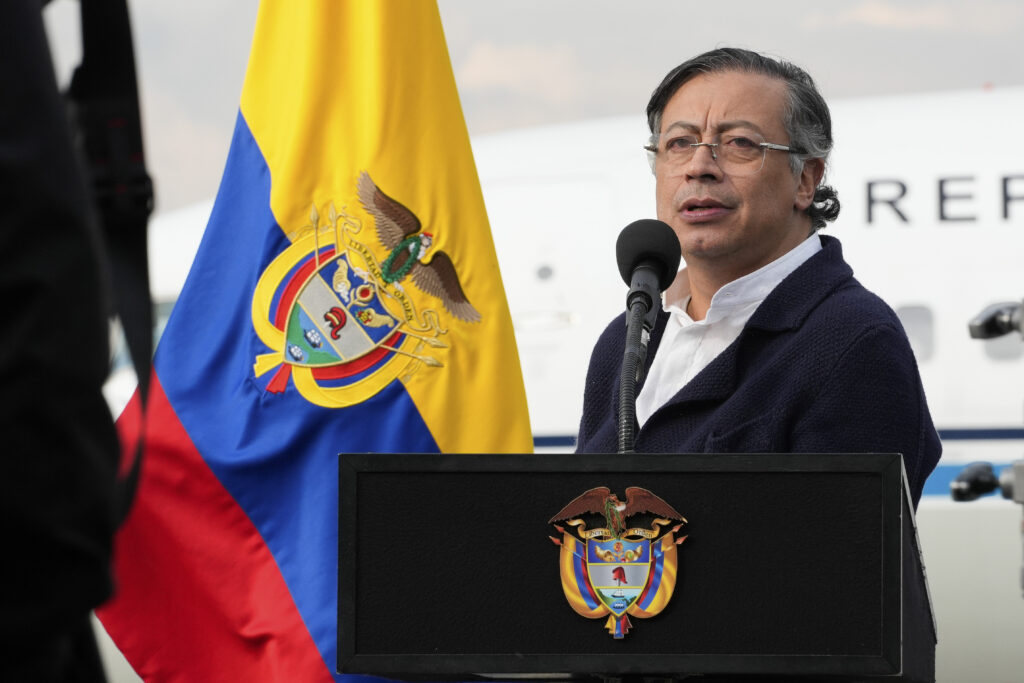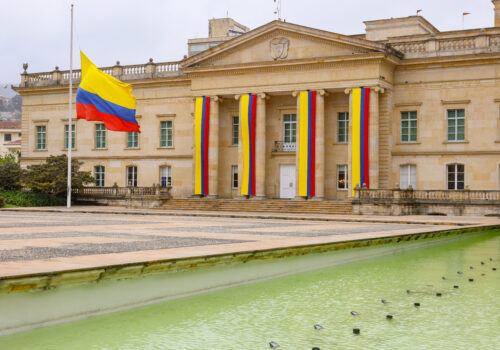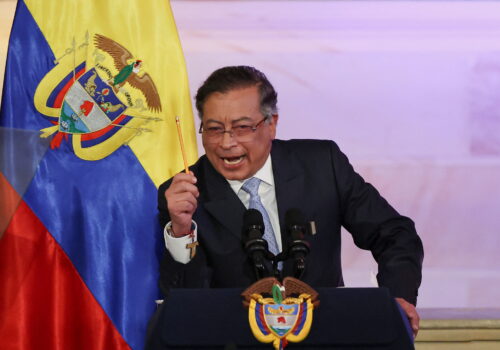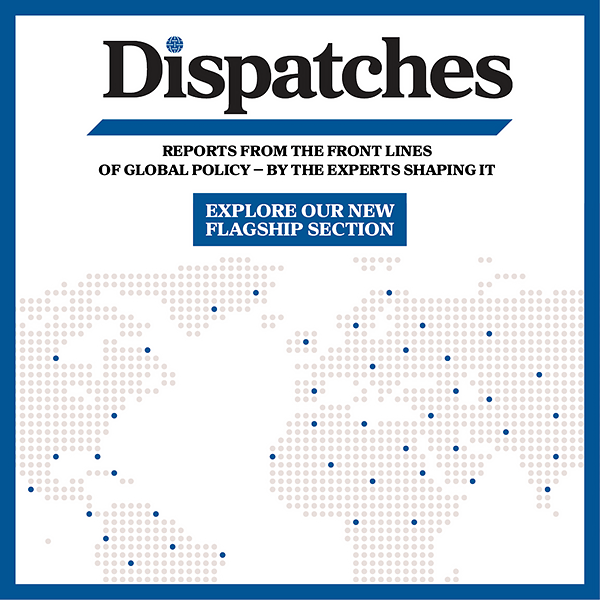The US-Colombia relationship has entered its most difficult chapter in recent memory—and the downward spiral is proceeding at a dizzying pace. New barbs between US President Donald Trump and Colombian President Gustavo Petro last weekend—and the resulting US announcement of a cancellation of US assistance to Colombia—are a wake-up call for how poor things have become. But there’s a longer-running history of close partnership between the countries, and that history points to the better place where the two allies can hopefully emerge.
The reasons for the recent downturn
The downward trend began three years ago—before the Trump administration took office. In September 2022, at his first United Nations General Assembly speech, Petro condemned the anti-drug efforts that have been a cornerstone of bilateral ties. This began a period of tensions between the two historically stalwart allies in which relations deteriorated further. During an April 2023 Capitol Hill visit, for example, Petro got into tense exchanges with US members of Congress Mario Diaz-Balart (R-FL) and Maria Elvira Salazar (R-FL).
And now, in the past month, tensions have come to a head. On September 15, the United States decertified Colombia as cooperating to fight drug trafficking – although it did grant a national interest waiver to maintain aid and security cooperation. Several days later, Petro took to the streets of New York City during the United Nations General Assembly to call for the US military to disobey the US president. And thus, for the first time in thirty years, the US State Department revoked the visa of the Colombian president. Add to that the latest Trump-Petro exchanges, which sprung from the US strikes on boats in the Caribbean. The background here: Petro accused the US government of “murder,” saying a wayward Colombian fisherman was killed in an airstrike, and Trump responded by calling Petro an “illegal drug dealer” as he revoked US aid to the country. Both parties are at a new low that would have been unimaginable at any point since bilateral ties were strengthened in 2000 with the launch of Plan Colombia.
The longer-term story of cooperation
In fact, the US-Colombia partnership has historically been more than just a bilateral relationship. In 2022, to celebrate two hundred years of US-Colombia diplomatic ties, the Atlantic Council’s Adrienne Arsht Latin America Center commissioned a series of essays and released a book titled Allies. In it, Kiron Skinner, who served at the US Department of State as the director for policy planning in the first Trump administration, wrote that Colombia had become “an indispensable security partner to the US, training police and prosecutors in Latin America and other regions.” That essay went on to acknowledge that “US intelligence and security cooperation with Colombia bore positive results for both countries over the past two decades.”
That cooperation—built over decades—is what should define the relationship. Intelligence sharing has led to the disruption of illicit trafficking routes, the dismantling of armed groups, and the strengthening of operational ties that have borne fruit in Colombia and in broader US efforts to impede narcotics smuggling.
China is another concern. In Allies, then Senator Roy Blunt (R-MO) wrote: “Colombia will be an excellent partner in countering the influence of our competitors. Chief among these competitors is China.” Two years later, Colombia, in another about-face from longstanding policy, joined the Belt and Road Initiative. And in August, Colombia signed an agreement with China to even further advance bilateral cooperation.
The trade and investment ties at stake
Petro’s pullback from the United States may be politically beneficial with some limited sectors in Colombia, but Colombians still see the United States as their principal ally, even though their preference for the United States has dropped. And that US preference is also seen among Colombia’s businesses—and the US businesses that export to Colombia. Strong people-to-people ties define the relationship as well as strong commercial ties.
Perhaps most notable in the commercial sphere is that the United States has a trade surplus with Colombia, and trade has continued to deepen. Since the US-Colombia Trade Promotion Agreement entered into force in 2012, Colombia’s exports of crude oil, coffee, flowers, avocados, bananas, apparel, and light manufacturing have increased to maximize favored tariff preferences. Likewise, US agricultural exports to Colombia have surged, hitting nearly five billion dollars in 2024—up over 20 percent from the previous year and the highest increase among the top twenty-five export markets for US agriculture. Two-way trade supports people and businesses in both countries.
Colombia has, for instance, become the fifth largest destination for US yellow corn in the world and the largest in South America, accounting for more than one billion dollars per year. This is all thanks to the benefits of the current bilateral free trade agreement. In terms of investment, the United States is the top source of foreign direct investment into Colombia, with an average of $2.5 billion going into the country each year since the free trade agreement started back in 2012. A deteriorating relationship between Washington and Bogotá could put this trade at risk.
Amid this accelerating decline in bilateral ties, both sides should remind themselves of the historical importance of this relationship in security, commercial, and broader geopolitical terms. That is ultimately what led to decades of bipartisan support for the relationship in the United States. As Colombia gears up for presidential elections in 2026, resurrecting a stronger bilateral relationship will be a top foreign policy issue across campaigns. Rightfully so. This is a relationship that cannot be lost. There’s way too much at stake.
Jason Marczak is vice president and senior director at the Atlantic Council’s Adrienne Arsht Latin America Center.
Further reading
Tue, Sep 2, 2025
Dispatch from Bogotá: This September is a pivotal moment for US-Colombia relations
New Atlanticist By Geoff Ramsey, Isabella Palacios
In the coming days, the White House has to decide whether to certify Colombia as a partner in the fight against transnational drug trafficking.
Tue, Sep 2, 2025
Take Colombia’s risk of democratic backsliding under Petro seriously
New Atlanticist By Enrique Millán-Mejía, Geoff Ramsey
Recent statements and proposals from Colombian President Gustavo Petro have raised concerns that his administration could spark a constitutional crisis.
Thu, Aug 7, 2025
Five charts that show how criminal organizations in Colombia work—and grow
New Atlanticist By
Our experts break down the numbers that show the reach, power, and influence of drug cartels and other transnational criminal organizations.
Image: Colombian President Gustavo Petro speaks in Bogota, Colombia, on September 17, 2025. Andrea Puentes/Pool / Latin America News Agency via Reuters Connect.




